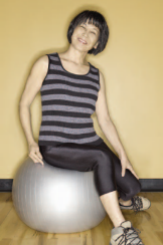Balance is key to activities of daily living, performance, fall prevention and independence. Balance can be affected by muscular strength and endurance, as well as proprioception, inner ear function and eye sight. It can be maintained and even improved as we age through practicing balance-specific training exercises. Research has shown that using specific tools in a safe environment can be particularly effective in improving your balance and enhancing your postural stability. Research has also shown that this type of training helps to reduce back, knee and ankle injuries.
A COMPLETE PHYSICAL ACTIVITY PROGRAM
A well-rounded physical activity program includes aerobic exercise and strength training exercise, but not necessarily in the same session. This blend helps maintain or improve cardiorespiratory and muscular fitness and overall health and function. Regular physical activity will provide more health benefits than sporadic, high intensity workouts, so choose exercises you are likely to enjoy and that you can incorporate into your schedule.
ACSM’s physical activity recommendations for healthy adults, updated in 2011, recommend at least 30 minutes of moderate-intensity physical activity (working hard enough to break a sweat, but still able to carry on a conversation) five days per week, or 20 minutes of more vigorous activity three days per week. Combinations of moderate- and vigorous intensity activity can be performed to meet this recommendation.
Examples of typical aerobic exercises are:
- Walking
- Running
- Stair climbing
- Cycling
- Rowing
- Cross country skiing
- Swimming.
In addition, strength training should be performed a minimum of two days each week, with 8-12 repetitions of 8-10 different exercises that target all major muscle groups. This type of training can be accomplished using body weight, resistance bands, free weights, medicine balls or weight machines.
BALANCE AND AGING
With age, balance tends to decline due to lower muscular strength and flexibility, as well as numerous other causes including loss of proprioception and inner ear problems. According to the National Institute of Health (NIH), nine percent of adults ages 65 and older report having difficulty with balance. This, along with a decline in lower body strength and stability, leads to an alarming 300,000 hospital admissions for fall-related injuries among older adults each year. The good news is that balance can be improved with simple exercises that can be done in therapy settings, health clubs or even at home.
ABOUT BALANCE TRAINING TOOLS
Balance training tools come in all shapes and sizes. They can be as simple as your own two feet or a pillow, or they can be made of foam, wood, rubber, springs, etc. These tools, along with balance training exercises, can rehabilitate, strengthen muscles and condition the body, as well as improve stability and postural alignment and help prevent falls. Men and women of all ages and activity levels can benefit from balance training. Start simply and progress slowly, gradually increasing the difficulty of the exercises.You may start with exercises such as balancing on one foot and then progress to using simple foam filled balance pads to challenge the body on an unstable surface.
BALANCE TRAINING TOOLS YOU CAN USE
Regular exercise, such as walking, can increase your strength and coordination, which are important for maintaining balance. The following provide more targeted balance training.
Balance Pillow – This foam-filled pad allows you to sit or stand (with one foot or two) on a spongy, unstable surface to improve posture and stability. This is a great tool for someone starting a balance training program.
Balance Disc – This tool is a round rubber disc inflated with air to create an unstable surface. Balance discs can be used while seated or standing to improve balance and coordination or to add intensity to body-strengthening exercises.
Blue Half-Ball – This is a stability ball cut in half with a flat, hard bottom.You can stand, sit or kneel on the air-filled ball portion of the tool or on the hard plastic side with the round surface down to create a rocking balance exercise. Blue half-balls are great for balance, core stability and proprioception training.
Foam Roller – This tool comes in a variety of shapes and sizes. These foam filled balance, posture and core training tools can be round, half-round, short (1′) or long (3′). To use this tool you may kneel, stand, lie or sit on the device.
Balance Board – The flat top to this tool allows you to stand and practice your balance while elevated on a spherical base. The range of motion that the device allows can be adjusted for changes in difficulty.
Stability Ball – This inflatable ball comes in different sizes and can be used as a balance and/or strength-training aid.
SAFETY AND CONSIDERATIONS
Balance training tools should only be used on a flat, stable, non-slip surface. Be sure to consult with your physician prior to starting a balance training program. Always practice balance training near a stable structure (such as a wall, bar or counter) to give you some assistance if you slip or begin to fall; or practice under the supervision of a qualified professional.
IMPLEMENTING A BALANCE TRAINING PROGRAM
When starting any new training program, it is important to use a gradual progression. Begin with low-intensity exercises and progress to more challenging exercises. When performing balance exercises, it is helpful to establish a stable, non-moving focal point. This will keep your attention and allow you to focus your eyesight for better stability.
GETTING STARTED
At first, you may start with simple balance training exercises – such as standing on one foot for a few seconds, and then gradually increasing your time for more difficulty.
General guidelines for balance training include:
- Start with a relatively stable foundation or position before progressing to a less stable foundation or position.
- Start with static or stationary position (holding a position) before adding any movement (e.g., walking or stepping) or resistance (e.g., adding a hand weight).
- From there, you may add movement to your balance pose, such as lifting your arms while still keeping your balance on one foot.
When you need to be challenged beyond this exercise, add a balance tool of your choice.You might start by sitting on a blue half-ball with two feet on the ground, and then move to one-footed contact while seated.You can move to standing on a blue half-ball with both feet while using a stationary aid like a wall, railing or chair for balance assistance. Finally, you can progress from standing on a blue half-ball without assistance to stepping on and off the half-ball with assistance, then without.
To get set up with a personalized program, one that is appropriate for your current fitness level and balance abilities, consult your physical therapist or fitness professional. To reduce risk of injury from falls, community dwelling older adults with substantial risk of falls (e.g., with frequent falls or mobility problems) should perform exercises that maintain or improve balance. Balance training should be performed daily for improvement in overall stability. Perform balance training before you do resistance training, so your muscles are not fatigued, to ensure that it works.
STAYING ACTIVE PAYS OFF!
Those who are physically active tend to live longer, healthier lives. Research shows that moderate physical activity – such as 30 minutes a day of brisk walking – significantly contributes to longevity. Even a person with risk factors like high blood pressure, diabetes or even a smoking habit can gain real benefits from incorporating regular physical activity into their daily life.
As many dieters have found, exercise can help you stay on a diet and lose weight. What’s more – regular exercise can help lower blood pressure, control blood sugar, improve cholesterol levels and build stronger, denser bones.
THE FIRST STEP
Before you begin an exercise program, take a fitness test, or substantially increase your level of activity, make sure to answer the following questions. This physical activity readiness questionnaire (PAR-Q) will help determine if you’re ready to begin an exercise routine or program.
- Has your doctor ever said that you have a heart condition or that you should participate in physical activity only as recommended by a doctor?
- Do you feel pain in your chest during physical activity?
- In the past month, have you had chest pain when you were not doing physical activity?
- Do you lose your balance from dizziness? Do you ever lose consciousness?
- Do you have a bone or joint problem that could be made worse by a change in your physical activity?
- Is your doctor currently prescribing drugs for your blood pressure or a heart condition?
- Do you know of any reason you should not participate in physical activity?
If you answered yes to one or more questions, if you are over 40 years of age and have recently been inactive, or if you are concerned about your health, consult a physician before taking a fitness test or substantially increasing your physical activity. If you answered no to each question, then it’s likely that you can safely begin exercising.
PRIOR TO EXERCISE
Prior to beginning any exercise program, including the activities depicted in this brochure, individuals should seek medical evaluation and clearance to engage in activity. Not all exercise programs are suitable for everyone, and some programs may result in injury. Activities should be carried out at a pace that is comfortable for the user. Users should discontinue participation in any exercise activity that causes pain or discomfort. In such event, medical consultation should be immediately obtained.
Reprinted with permission of the American College of Sports Medicine. Copyright © 2011 American College of Sports Medicine. This brochure was created and updated by Jennifer Jens, B.S, and is a product of ACSM’s Consumer Information Committee. Visit ACSM online at www.acsm.org.






